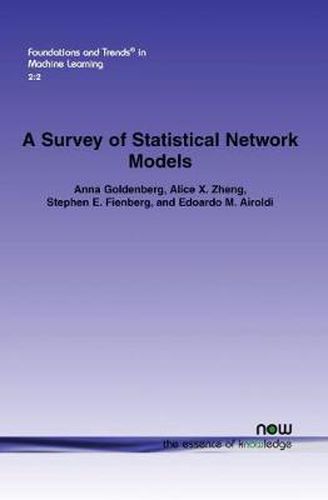Readings Newsletter
Become a Readings Member to make your shopping experience even easier.
Sign in or sign up for free!
You’re not far away from qualifying for FREE standard shipping within Australia
You’ve qualified for FREE standard shipping within Australia
The cart is loading…






This title is printed to order. This book may have been self-published. If so, we cannot guarantee the quality of the content. In the main most books will have gone through the editing process however some may not. We therefore suggest that you be aware of this before ordering this book. If in doubt check either the author or publisher’s details as we are unable to accept any returns unless they are faulty. Please contact us if you have any questions.
Networks are ubiquitous in science and have become a focal point for discussion in everyday life. Formal statistical models for the analysis of network data have emerged as a major topic of interest in diverse areas of study, and most of these involve a form of graphical representation. Probability models on graphs date back to 1959. Along with empirical studies in social psychology and sociology from the 1960s, these early works generated an active network community and a substantial literature in the 1970s.
This effort moved into the statistical literature in the late 1970s and 1980s, and the past decade has seen a burgeoning network literature in statistical physics and computer science. The growth of the World Wide Web and the emergence of online networking communities such as Facebook, MySpace, and LinkedIn, and a host of more specialized professional network communities has intensified interest in the study of networks and network data.
The goal of this book is to provide the reader with an entry point to this burgeoning literature. It begins with an overview of the historical development of statistical network modeling and then introduces a number of examples that have been studied in the network literature. Subsequent discussions focus on a number of prominent static and dynamic network models and their interconnections. The authors emphasize formal model descriptions, and pay special attention to the interpretation of parameters and their estimation. They end with a description of some open problems and challenges for machine learning and statistics.
$9.00 standard shipping within Australia
FREE standard shipping within Australia for orders over $100.00
Express & International shipping calculated at checkout
This title is printed to order. This book may have been self-published. If so, we cannot guarantee the quality of the content. In the main most books will have gone through the editing process however some may not. We therefore suggest that you be aware of this before ordering this book. If in doubt check either the author or publisher’s details as we are unable to accept any returns unless they are faulty. Please contact us if you have any questions.
Networks are ubiquitous in science and have become a focal point for discussion in everyday life. Formal statistical models for the analysis of network data have emerged as a major topic of interest in diverse areas of study, and most of these involve a form of graphical representation. Probability models on graphs date back to 1959. Along with empirical studies in social psychology and sociology from the 1960s, these early works generated an active network community and a substantial literature in the 1970s.
This effort moved into the statistical literature in the late 1970s and 1980s, and the past decade has seen a burgeoning network literature in statistical physics and computer science. The growth of the World Wide Web and the emergence of online networking communities such as Facebook, MySpace, and LinkedIn, and a host of more specialized professional network communities has intensified interest in the study of networks and network data.
The goal of this book is to provide the reader with an entry point to this burgeoning literature. It begins with an overview of the historical development of statistical network modeling and then introduces a number of examples that have been studied in the network literature. Subsequent discussions focus on a number of prominent static and dynamic network models and their interconnections. The authors emphasize formal model descriptions, and pay special attention to the interpretation of parameters and their estimation. They end with a description of some open problems and challenges for machine learning and statistics.